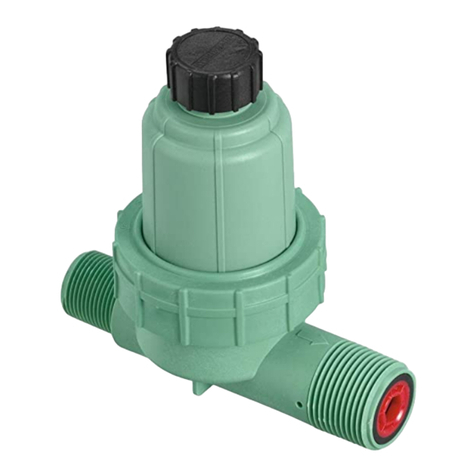
8
Your controller is equipped with the simple “screw-in” terminals for
easy connection. Connect common wires to the common terminals.
Connect remaining wires to corresponding terminal locations.
4. Connect Electrical Power
WARNING: Never connect two or more power supplies in parallel.
Indoor Locations – Insert the power cord into an 110V electrical
outlet.
WARNING – Risk of Electric Shock. Install power unit 5 feet
(1.5 m) or more from a pool, spa, or fountain. Where power
unit is installed indoors within 10 feet (3.0 m) of a pool, spa,
or fountain, connect to power unit receptacle protected by a
GDCI.
Outdoor Locations – If a covered Ground Circuit Fault
Interrupter (GFCI) outlet is available, insert the power cord into
the 110V electrical outlet. If no outlet is available, the controller
must have the wiring permanently installed. See Figure 5.
•Turn off the AC power at the AC circuit breaker and
apply an appropriate safety lockout. Verify that the power
has been turned off to the installation site using an AC
voltmeter set for the correct measurement range.
•Use power feed wire of 14 gauge (AWG) minimum with
a temperature rating of 155 degrees Fahrenheit (68
degrees Celsius) or higher.
•Install the conduit and associated fittings. Connect the
AC electrical power wiring to the source by following all
the right codes and local standards.
•Connect the junction box to the controller using a 1/2 inch
nipple (junction box and nipple not included). Connect the
source power conduit to the entrance of the junction box,
following all the appropriate codes. See Figure 5.
•Take the cord (running from the controller to the junction
box) from the junction box and cut it to length. Remove the
outer insulation (from cord) to expose the three wires.
•Connect the source wires to the wires extending from the
sprinkler controller.
•For USA: Take care to follow the correct color code.
Connect the Green for Ground, Black for Live, and White
for Neutral. Often the source ground may be bare copper
conductor rather than green wire.
•Make sure all connections are made with code-approved
insulated connectors.
•Be sure to place a weatherproof gasket and lid on the
junction box.
•Turn AC power on at the AC circuit breaker.
WARNING – Risk of Electric Shock. Install power unit 5 feet
(1.5 m) or more from a pool or spa and 10 feet (3.0 m) from a
fountain. Where power unit is installed within 10 feet (3.0 m)
of a pool or spa connect power unit to a GFCI protected branch
circuit. Do not use an extension cord. Power unit must be
connected to a protected GFCI hooded flush type cover plate
receptacle marked "Wet Location"while in use.
Important: Installation Using Permanant Wiring
The landscape lighting controller has a built-in transformer
that must be connected to an AC line voltage source. Check
inside the cover door of the landscape lighting controller
box for power requirements. Local building and electrical
codes usually require that an approved electrical conduit and
electrical fittings be used to connect exterior wall-mounted
equipment to AC power. Please check local codes. Any
permanent connection should be made by a licensed electrical
contractor in accordance with the requirements of the National
Electrical Code and other state and local codes.
This landscape lighting controller has two holes at the bottom
for wire access. Use a 1/2 inch nipple to connect the landscape
lighting controller to a standard electrical junction box. Both
connector and junction box must be UL Listed or equivalent or
comply with IEC or EN standards or equivalent.
½" Connector
Junction Box
3 Wire
Connectors
RESET
PROGRAM
RAIN DELAY
RUN
OFF
SET
CLOCK
SET
DATE
BUDGET
HOW
OFTEN
RUN
TIME
START
TIME
TEST CYCLE
Figure 5: Using a Junction Box































